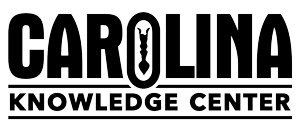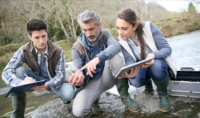Make an Environmental Connection
You’ve probably seen it on a bumper sticker, “Think Globally, Act Locally.” Have you ever thought about how it might relate to the way we teach our students? Relating global concepts such as water quality and pollution to a local body of water through watershed assessment and water quality monitoring can offer a wonderful learning opportunity. As students connect to their community through research, they can become better citizens and stewards of the environment because they have firsthand knowledge of the results of others” actions or inaction.
A water quality monitoring program can be developed for elementary school through college classes in urban, suburban, and rural settings. Does this sound like a great idea to you? Want to know how to start? Just read the following 5 steps, and you’ll be well on your way to developing a water quality monitoring program of your own.
1. Locate a suitable body of water for your study
You should pick a body of water that is easy for you and your students to access. It may be a stream, a lake, or an estuary. For help in determining your local watershed, you can visit the EPA’s Surf Your Watershed. It’s a great resource that not only helps you determine which watershed you are in, but also lists data collected by federal, state, and local agencies. In addition, the Web site lists local citizen groups that are already at work in your area. These groups can be a wonderful resource, helping you decide where to focus your efforts.
2. Determine what types of data your students can easily collect
Water quality data can be collected by students of all ages and abilities. Data collected usually include the following physical, chemical, and biological parameters:
Physical
- Visual survey of the area, including description of the landscape and the surrounding land use
- Velocity/water level
- Turbidity
- Secchi disk visibility
- Temperature–ambient and water
Chemical
Chemical testing can be done using a variety of methods, ranging from simple test strip or tablet methods similar to the Earth Force® Standard Water Monitoring kits, to more complex (but higher resolution) titrimetric tests like those included in the LaMotte® Deluxe Water Quality Education Outfit. Use the methods most appropriate to your students’ grade level and capabilities to measure the following:
- pH
- Dissolved oxygen
- Biochemical oxygen demand (BOD)
- Nitrates
- Phosphate
- Alkalinity
- Total dissolved solids (TDS)
Biological
A biological survey of the visible organisms in your body of water helps in determining its health. Be sure to survey as many of the following as you can:
- Plants along the banks and in the water, including algae
- Fish species
- Macroinvertebrates–snails, worms, fly larvae, and crawfish are a few. Resources like the LaMotte® macroinvertebrate cards, Carolina® macroinvertebrate cards, and the LaMotte® Leaf Pack Stream Ecology Kit can be very helpful in identifying them.
- Microbiological organisms, such as fecal coliform bacteria, which can indicate sewage or manure runoff. Consider the LaMotte® BioPaddle® Total Coliform Activity Kit or the Water Pollution: Coliform Presumptive Test Kit.
For more information about setting up a monitoring program, visit EPA Volunteer Monitoring, where you can access monitoring method manuals for streams, lakes, and estuaries.
3. Determine who will use the data you collect
The data you collect is valuable. At the very least it can be used to create a database for your class to follow water quality from season to season and year to year. You can use your results to determine a water quality index (WQI) to help evaluate the health of your watershed. Calculating NSF Water Quality Index provides an easy-to-use calculator to determine a WQI.
Your data can also be used by organizations like World Water Monitoring Day to report on the overall health of water around the world. To participate, you need to collect the following measurements once between March 22 and December 31 each year.
- temperature
- turbidity
- pH
- dissolved oxygen
There is also The Secchi Dip-In during June and July where transparency results from your body of water can be collected using a Secchi Disk or the Carolina™ Turbidity Tube and recorded at The Secchi Dip-In. Data collected using more advanced methods can even be used by organizations like the EPA if you follow one of their Quality Assurance Project Plans (QAPP).
4. Determine what you will do with the knowledge you gain
If through your monitoring you find there are problems in your local body of water, investigate to determine whether any policies or procedures are leading to decreased water quality. This real-world information can then be used to brainstorm alternative solutions and create an action plan. Organizations such as Earth Force can be great resources. Or use the experience of water quality monitoring as a springboard to educate the community around you through programs like Project Wet’s Water Festivals.
5. Obtain funding for your project
Budgeting is tight everywhere, but depending on the scope of your project there are numerous sources of funding available to help you achieve your goals. Here are just a few places to start:
Federal government
- EPA Environmental Education Grants
- Grants.gov is a clearinghouse of grants for all types of projects within the federal government, but you may be able to find one that suits your needs.
National and regional organizations
Corporate
Most large companies are currently engaged in green initiatives and have grants and mini-grants to help with environmental education or have funding for educational projects in general. Here are just a few:
Conclusion
As you’ve read, you can develop a water quality monitoring program to fit nearly every grade level and locale. The data your students collect has value not only as an immediate learning tool, but can be shared and archived locally, nationally, and even internationally for research and other purposes. This not only gives students the opportunity to learn, but to become better citizens and stewards of the environment, as well. Carolina has everything you need to start and maintain a water quality monitoring program.




